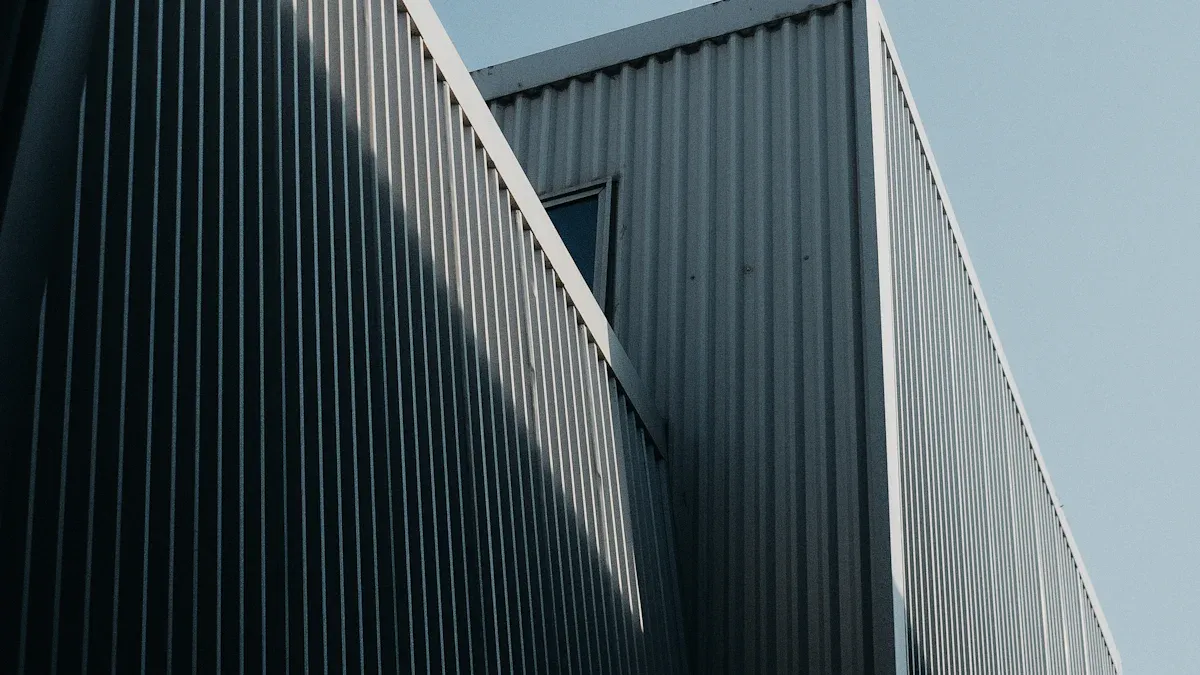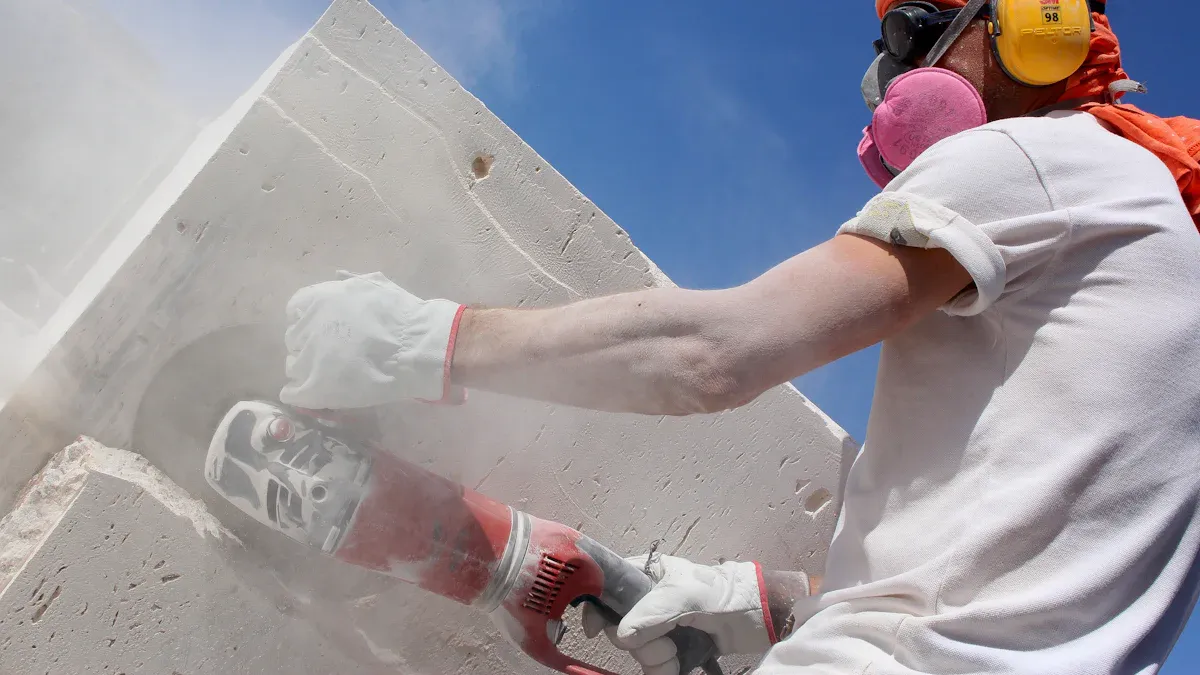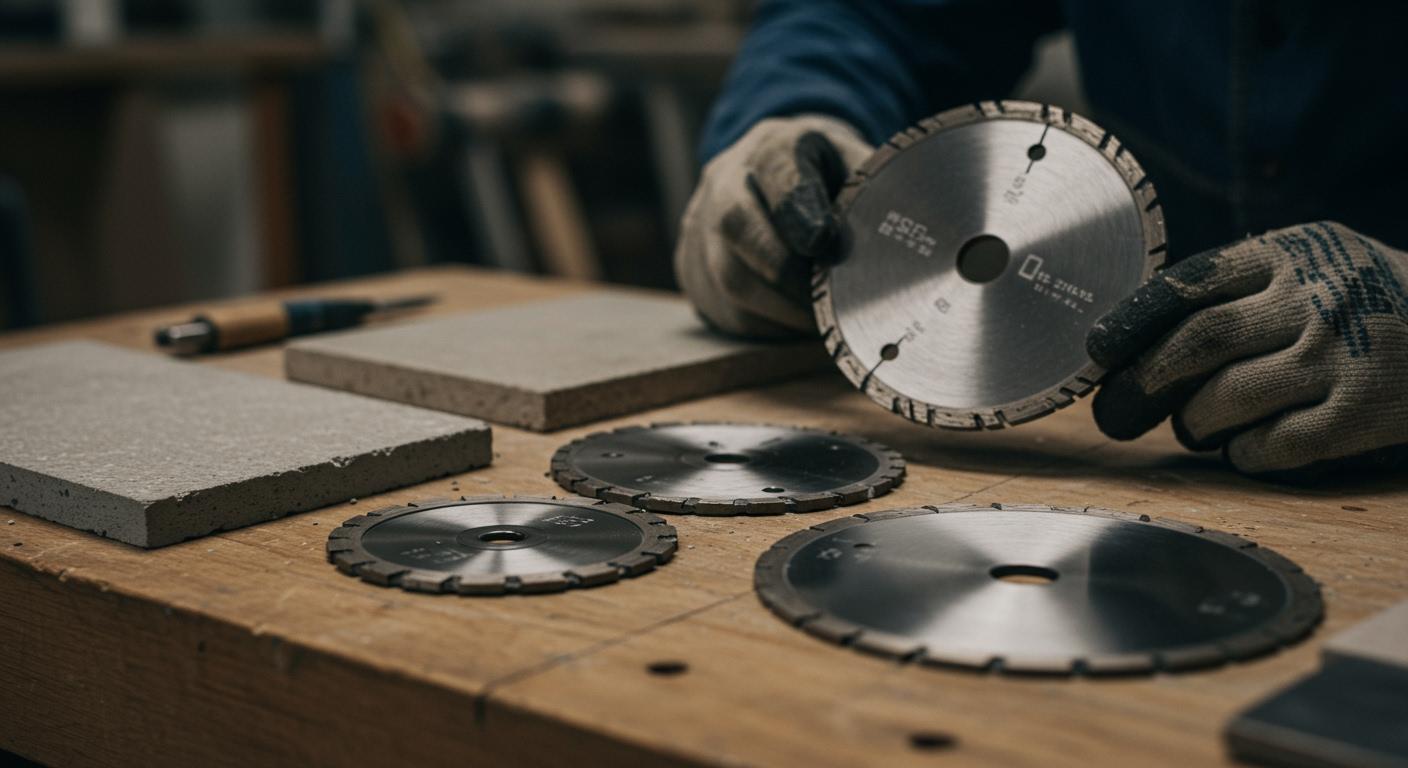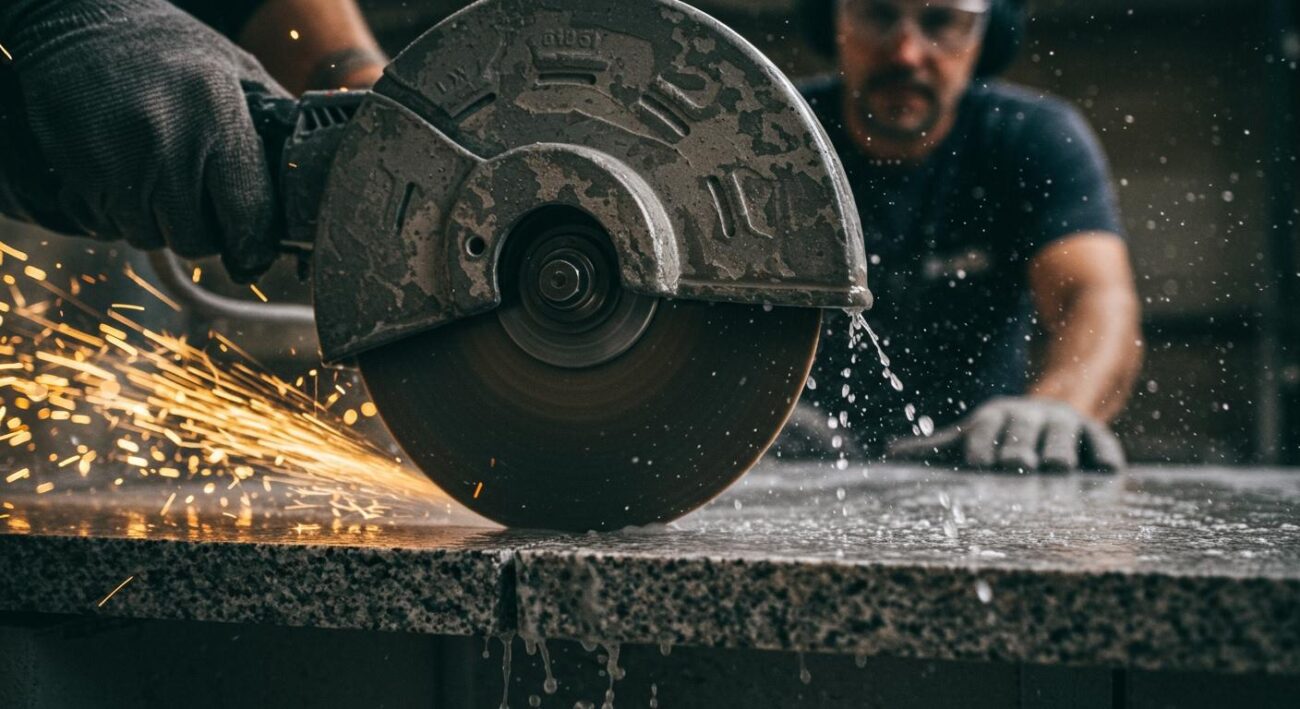Choosing from the vast selection of diamond saw blades for your project can feel overwhelming. The market’s significant size highlights how essential these tools are.
| Key Metric | Value |
|---|---|
| Diamond Saw Blade Market Size (2024) | USD 8.4 Billion |
| Projected Market Size (2032) | USD 10.16 Billion |
| CAGR (2025-2032) | 2.41% |
Note: Your project success depends on one critical rule: you must match the diamond blade to the material. This single step prevents most cutting issues. Using the wrong blade type is a costly mistake. Understanding a blade’s features helps you select the perfect diamond blade for any cutting project.
Key Takeaways
- Match the diamond blade’s bond to your material. Use a soft bond for hard materials and a hard bond for soft materials.
- Choose the right blade edge for your task. Segmented blades cut fast, turbo blades offer a good balance, and continuous blades give the smoothest finish.
- Use wet cutting whenever you can. Water cools the blade, makes it last longer, and keeps dust down for safety.
- Always check the blade’s size and speed rating. Make sure they match your saw to prevent accidents and damage.
Understanding Key Diamond Blade Features
The bond is the most important of all diamond blade features. The bond is the metal matrix that holds the diamond crystals in place. The hardness of this bond determines how the blade performs and how long it lasts. You must match the bond hardness to the material you are cutting. This is the “Golden Rule” of diamond blade selection.
The Golden Rule of Bonds 💡
- Use a soft-bond blade for hard, dense materials.
- Use a hard-bond blade for soft, abrasive materials.
Understanding this rule helps you achieve the best cutting performance. Let’s explore each bond type.
Soft Bonds for Hard Materials
You should choose a blade with a soft bond when cutting very hard, dense materials. These materials do not wear down the blade’s segments quickly.
- Reinforced Concrete
- Granite and Quartzite
- Porcelain and Tile
- Hard Stone and Brick
A soft bond wears away easily. This is a good thing when cutting hard materials. The cutting action dulls the exposed diamonds quickly. The soft bond erodes at the right rate to expose new, sharp diamonds underneath. This self-sharpening process keeps your concrete saw cutting efficiently. If you use a bond that is too hard for the material, you will notice problems. The blade will stop cutting effectively. This is called “glazing,” where the diamonds become smooth and the blade just polishes the surface.
Warning Signs of a Mismatched Blade:
- The blade cuts much slower than normal.
- You see smoke or signs of burning.
- The blade’s segments look smooth and shiny (glazed).
- Your concrete saw starts to hammer, which can cause cracks or segment loss.
Hard Bonds for Abrasive Materials
You need a hard-bond diamond blade for soft, abrasive materials. These materials act like sandpaper. They can rapidly wear away a soft bond and waste the diamonds before you use them fully. A hard bond is tough. It resists this abrasive wear. This holds the diamonds in place longer, giving you the full life of the blade.
Choose a hard-bond blade for materials like:
- Asphalt
- Green Concrete (freshly poured concrete)
- Sandstone
- Concrete Block
Using a hard bond on these materials ensures your concrete saw maintains its cutting power. The bond is strong enough to prevent premature erosion. This gives you a durable and effective cutting experience when working with abrasive concrete. This type of blade is essential for roadwork and projects involving green concrete.
Medium Bonds for General Use
Sometimes your project involves a mix of materials, or you need a single blade for general-purpose work. A medium-bond blade offers a balance between blade life and cutting speed. This makes it a versatile choice for materials that are neither extremely hard nor highly abrasive. You can use this blade type on a concrete saw for jobs involving cured concrete or pavers.
| Material Type | Recommended Bond | Rationale |
|---|---|---|
| Hard Materials (Granite, Reinforced Concrete) | Soft | Bond must wear to expose new diamonds. |
| General Use (Cured Concrete, Marble) | Medium | A balanced mix of cutting speed and blade life. |
| Abrasive Materials (Asphalt, Green Concrete) | Hard | Bond must resist abrasion to hold diamonds longer. |
Getting the perfect match is key. Expert suppliers specialize in creating solutions for specific needs. For instance, Aimgrind offers a wide range of high-performance cutting tools, including advanced diamond and CBN cutting wheels. Their focus on customized formula design ensures you can get a blade perfectly matched to your material, whether it’s for a large concrete project or precision work. The right diamond saw blades will improve your project’s efficiency and final quality.
Choosing the Right Edge for Your Project

After you select the right bond, your next decision is the blade’s edge design. The rim style directly impacts cutting speed, the quality of the finish, and how the blade cools itself. Each edge type is engineered for specific tasks and materials. You must choose the right edge to get the best results for your project.
There are three main types of diamond saw blades: segmented, turbo, and continuous rim. Each offers a different balance of speed, precision, and blade life.
| Feature | Segmented Diamond Blade | Turbo Diamond Blade | Continuous Diamond Blade |
|---|---|---|---|
| Rim Style | Grooves (gullets) along the edge | Continuous but serrated edge | Solid, continuous edge |
| Cutting Speed | Very good | Excellent | Slower, for precision |
| Cutting Quality | Rougher, may cause chipping | Smooth, with minimal chipping | Chip-free, finest finish |
| Primary Use | Aggressive cutting of hard materials | Fast, clean cutting on various materials | Delicate cutting of brittle materials |
| Cooling | Airflow through gullets | Cooling holes and serrated edge | Requires water for cooling |
| Application | Dry and wet cutting | Dry and wet cutting | Wet cutting only |
Segmented Diamond Saw Blades
You will recognize a segmented diamond blade by the distinct gaps, or gullets, along its edge. These gullets look like U-shaped or keyhole-shaped slots. This design is built for aggressive, fast cutting. The gullets are not just for looks; they serve a vital purpose. They allow air to flow through the blade, which helps cool it down during intense use with a concrete saw. These gaps also clear away dust and debris, keeping the cutting path clean and efficient.
This blade type is your best choice for heavy-duty jobs involving hard or abrasive materials. Use a segmented blade for:
- Concrete and reinforced concrete
- Asphalt
- Brick and masonry block
- Pavers
These blades are the workhorses for general construction and roadwork. You can use them for both wet and dry cutting, making them very versatile for any project. A concrete saw equipped with a segmented blade can handle demanding tasks effectively.
Warning: Risk of Chipping ⚠️
The aggressive nature of a segmented blade has one main drawback. It can cause chipping or leave a ragged edge on brittle materials. Avoid using this blade on tile, porcelain, or glass where a clean finish is the goal. The blade’s power is too rough for delicate surfaces.
Turbo Rim Blades
A turbo rim blade offers a great balance between the aggressive power of a segmented blade and the smooth finish of a continuous rim blade. It has a continuous rim, but it is serrated with a pattern that helps with cooling and speed. This hybrid design makes it a high-performance, all-purpose option for many materials. It provides a faster, cleaner cut than a segmented blade.
You can use a turbo rim blade on your concrete saw for a wide range of universal construction materials. It is an excellent choice for a project that involves cutting:
- Concrete
- Stone and granite
- Brick
- Roofing tile
This blade gives you fast cutting action with less chipping than a segmented blade. This makes it a popular choice for contractors who need a single, reliable blade for multiple tasks on the job site.
Continuous Rim Blades
When your project demands the cleanest and most precise cuts, you need a continuous rim diamond blade. This blade has a solid, uninterrupted edge with no segments or gullets. This design grinds through material smoothly instead of chipping at it. The solid edge is critical for preventing chips when cutting fragile materials. This makes it the only choice for achieving flawless precision cuts.
This blade is ideal for materials where the finish quality is most important:
- Porcelain and ceramic tile
- Glass
- Marble and granite slabs
Important Note: You must use continuous rim blades with water. The solid edge generates a lot of heat. Water acts as a coolant to prevent the blade and material from overheating. It also lubricates the cut, washing away dust and slurry. This process ensures a smooth, chip-free finish and extends the life of your blade. Using this blade on a wet-cutting concrete saw is essential for high-precision work.
Wet vs. Dry Cutting Methods

You must also decide between wet or dry cutting. This choice affects your blade’s lifespan, the quality of your cut, and job site safety. Each method has specific benefits and is suited for different project conditions.
Wet Cutting Benefits
You should use wet cutting whenever possible. This method uses water to deliver major advantages for both your tool and your health.
Key Benefits of Wet Cutting 💧
- Extends Blade Life: Water is the best way to cool your blade. It prevents overheating and warping. This proper maintenance helps the diamond blade last much longer.
- Improves Performance: The water flushes away dust and slurry from the cut. This reduces friction and helps the blade’s cutting action, leading to faster, more efficient cutting.
- Enhances Safety: Cutting materials like concrete creates harmful silica dust. OSHA recognizes wet cutting as a primary method to control this dust. This is one of the most important safety features for protecting you and your team.
Using a continuous flow of water is essential for achieving the highest precision and a clean finish, especially on delicate materials. For most concrete cutting jobs, wet cutting is the superior choice.
When to Use Dry Cutting
Sometimes, dry cutting is your only practical option. You might choose dry cutting for quick, small jobs where setting up a water supply is not practical.
You can use dry cutting in these situations:
- Outdoor work on concrete where no water is available.
- Small indoor jobs, like decorative cutting or patterning.
- Intermittent cutting with a handheld saw.
You must use a blade specifically designed for dry cutting. These blades have features like laser-welded segments to handle the extra heat. However, dry cutting creates a large amount of dust. You must use proper dust extraction systems and wear a respirator. Dry cutting is best for short, shallow cutting tasks, not for prolonged, deep cuts in hard concrete. It offers convenience but requires more caution.
Final Checks for Your Project Requirements
You have matched the bond and edge to your material. Now you must complete the final checks for your project requirements. You need to confirm the blade is compatible with your concrete saw. This step is crucial for safety and performance. Ignoring these details can damage your cutting tools and create serious hazards on your project.
Blade Diameter and Arbor Size
You must match the blade’s size to your saw’s specifications. Check your saw’s manual to find the correct blade diameter and arbor size for your project.
- Blade Diameter: This is the blade’s overall size. Using a blade that is too large for your concrete saw can cause it to hit the safety guard. This is a major risk.
- Arbor Size: This is the size of the hole in the center of the blade. It must fit perfectly onto the saw’s mounting shaft, or arbor. Common arbor sizes are 5/8″ for smaller saws and 1″ for larger table saws.
Safety First! ⚠️
A blade with an arbor hole that is too large will wobble. This leads to an uneven cut and can damage the blade. A blade with a hole that is too small will not fit at all. Forcing it can damage your concrete saw. Always choose a blade that fits your saw perfectly for your project.
Saw and Blade RPM Rating
Every diamond blade has a maximum RPM (Revolutions Per Minute) rating. This number is the fastest speed the blade can safely spin. You must check this rating. Your saw’s operating RPM must be lower than or equal to the blade’s maximum RPM. This is one of the most important safety features to check for your project.
Operating a blade above its RPM limit is extremely dangerous.
- The blade can crack, warp, or even shatter under the stress.
- Excessive speed puts major strain on your concrete saw motor and bearings. This leads to poor performance and costly repairs.
- Proper maintenance of your cutting tools includes respecting their operational limits.
Ensuring your equipment meets all project requirements protects you and your concrete saw. This final check guarantees a safe and successful project.
You now understand how to select the right diamond saw blades for your project. You must match the bond, choose an edge type, and select a cutting method. This process ensures efficient cutting for your project. Verifying saw compatibility for your project guarantees a safe cutting experience.
You can now confidently choose the perfect diamond blade. This knowledge empowers you to achieve efficient cutting on any project with the right diamond blade.
FAQ
What should I do if my blade stops cutting?
Your blade is likely glazed. You can fix this by making a few cuts into an abrasive material, like a concrete block or a dressing stone. This action wears away the dull bond layer. It exposes new, sharp diamonds and restores the blade’s cutting ability.
Can I use one blade for both concrete and asphalt?
You should avoid using one blade for both. Concrete is hard, while asphalt is abrasive. Each material requires a different bond type for best results. Using the wrong blade leads to slow cutting, premature wear, and potential damage to your cutting tools.
How do I choose a wheel for a special material?
For unique materials, you should consult an expert. Specialized suppliers like Aimgrind offer custom solutions. They analyze your material and equipment to design a cutting wheel with the perfect formula, ensuring optimal performance and efficiency for your specific project.
Why is my blade’s RPM rating important?
The RPM rating is a critical safety limit. You must ensure your saw’s RPM does not exceed the blade’s maximum RPM. Exceeding this limit can cause the blade to break apart during use. This creates a serious safety hazard for you and your team.
See Also
Selecting the Perfect Grinding Wheel for Your Circular Saw Blade
Optimal Grinding Wheels: A Guide for Your Carbide Tool Sharpening
Picking the Ideal Metal Grinding Wheel for Your Specific Project
Finding the Most Effective Grinding Wheel Dresser for Your Workshop
Selecting the Appropriate Bench Grinding Wheel Material for Your Tasks
Contact Us
For More Grinding Solution or Customized Abrasive Tools


